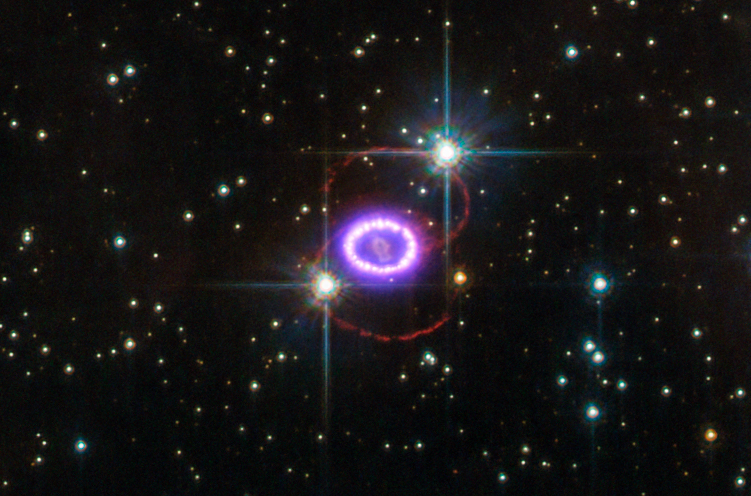When stars reach the end of their life cycle, many will blow off their outer layers in an explosive process known as a supernova. While astronomers have learned much about this phenomena, thanks to sophisticated instruments that are able to study them in multiple wavelengths, there is still a great deal that we don't know about supernovae and their remnants.
For example, there are still unresolved questions about the mechanisms that power the resulting shock waves from a supernova. However, an international team of researchers recently used data obtained by the Chandra X-Ray Observatory of a nearby supernova (SN1987A) and new simulations to measure the temperature of the atoms in the resulting shock wave.
The study, titled " Collisionless shock heating of heavy ions in SN 1987A ", recently appeared in the scientific journal Nature. The team was led by Marco Miceli and Salvatore Orlando of the University of Palermo, Italy, and was made up of members from the National Institute of Astrophysics (INAF), the Institute for Applied Problems in Mechanics and Mathematics, and Pennsylvania State and Northwestern University.
For the sake of their study, the team combined Chandra observations of SN 1987A with simulations to measure the temperature of atoms in the supernova's shock wave. In so doing, the team confirmed that the temperature of the atoms is related to their atomic weight, a result which answers a long-standing question about shock waves and the mechanisms that power them.
As David Burrows, a professor of astronomy and astrophysics at Penn State and a co-author on the study, said in a Penn State press release:
When larger stars undergo gravitational collapse, the resulting explosion propels material outwards at speeds of up to one tenth the speed of light, pushing shock waves into the surrounding interstellar gas. Where the shock wave meets the slow-moving gas surrounding the star, you have the "shock front". This transition zone heats the cool gas to millions of degrees and leads to the emission of X-rays that can be observed.
For some time, astronomers have been interested in this region of a supernova's shock wave, since it marks the transition between the explosive force of a dying star and the surrounding gas. As Burrows likened it:
By examining the temperatures of different elements behind a supernova's shock front, astronomers hope to improve our understanding of the physics of the shock process. While the elements' temperatures have been expected to be proportional to their atomic weight, obtaining accurate measurements have been difficult. Not only have previous studies led to conflicting results, they have also failed to include the heavy elements in their analyses.
To address this, the team looked on Supernova SN1987A, which is located in the Large Magellanic Cloud and first became apparent in 1987. It addition to being the first supernova that was visible to the naked eye since Kepler's Supernova (1604), it was the first to be studied in all wavelengths of light (from radio waves to X-rays and gamma waves) with modern telescopes.
Whereas previous models of SN 1987A have typically relied on single observations, the research team used three-dimensional numerical simulations to show the evolution of the supernova. They then compared these to X-ray observations provided by Chandra to accurately measure the atomic temperatures, which confirmed their expectations.
"We can now accurately measure the temperatures of elements as heavy as silicon and iron, and have shown that they indeed do follow the relationship that the temperature of each element is proportional to the atomic weight of that element," said Burrows. "This result settles an important issue in the understanding of astrophysical shock waves and improves our understanding of the shock process."
This latest study represent a significant step for astronomers, bringing them closer to an understanding of the mechanics of a supernova. By unlocking their secrets, we stand to learn more about a process that is fundamental to cosmic evolution, which is how the death of stars impact the surrounding Universe.
*Further Reading: Penn State*, Nature
 Universe Today
Universe Today


